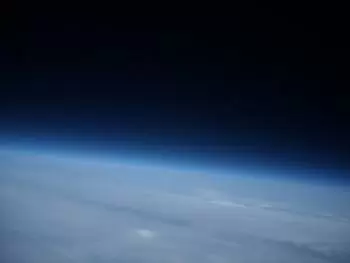
The stratosphere is the layer of the Earth's atmosphere between the troposphere and the mesosphere. The tropopause and the stratopause separate the layers, respectively, the two transition zones between layers.
The stratosphere is approximately 30 kilometers thick and comprises oxygen and nitrogen atoms and ozone molecules. In this region, air temperature increases with altitude.
How high is the stratosphere?
The height of the stratosphere depends on the terrestrial point where it is measured. We have to take into account that the Earth has an oval shape due to the magnetism of the poles:
-
At the equator, the stratosphere begins at about 17 km altitude above the Earth's surface (sea level)
-
At the poles, the layer starts at about 10 kilometers in height.
Above this layer, there is the troposphere. On the other side, over it, the mesosphere begins at an altitude of 50 km from the Earth's surface.
Why does the temperature increase in the stratosphere?
In the stratosphere, the temperature increases with altitude because of the absorption of ultraviolet radiation from the Sun.
Unlike the underlying troposphere, the beginning of this layer is characterized by a nearly constant temperature with increasing altitude, the isothermal layer. Above that, the stratosphere’s temperature increases with height, and at about 47 km, it reaches freezing again.
As the temperature decreases with height, the stratosphere transforms into the mesosphere. It is about -50 °C at the lowest point of the layer and between 0 and 30 °C at the highest point.
The amount of penetrating ultraviolet (UV) radiation decreases as the distance from Earth decreases. Combined with a higher density of the atmosphere, this translates into a drop in temperature.
Sudden stratospheric warming can cause temperatures to spike tens of degrees Celsius in winter.
The mesosphere starts on the top of the stratosphere. In the mesosphere, the temperature decreases with altitude again.
How is good stratospheric ozone formed?
Ozone is a highly reactive colorless gas consisting of three oxygen atoms (O3 ). It is found naturally in the two lower layers of the atmosphere.
Natural tropospheric ozone comes from transport from the stratosphere and photochemical formation.
This last process occurs when volatile organic compounds (VOC), carbon monoxide (CO), and nitrogen oxides (NOx ) interact through chemical reactions caused by solar radiation.
In an atmosphere not altered by human activity, these reactions are part of the carbon cycle. Through the carbon cycle, VOCs that are emitted naturally by vegetation or by biological activity in wetlands, among others, turn out CO2 and steam.
Due to the vertical course of temperature, the stratosphere is stable, and there is practically no convection or turbulence. As a result, hardly any clouds form, but nacreous clouds can form in icy polar winters. These clouds are essential in creating ozone molecules that absorb ultraviolet rays from the sun.
What is the difference between tropospheric ozone and stratospheric ozone?
There is a significant difference in composition between the troposphere and the stratosphere. For example, the stratosphere contains more ozone molecules and less water vapor and carbon dioxide than the troposphere.
The lack of vertical air motion means that pollution, once present, can remain in this layer for a long time.
What is the proportion of ozone in each layer?
For the most part, practically 90% of Earth’s ozone is located in the stratosphere. Here the ozone forms what is known as the Ozone Layer.
The remaining 10% of all ozone is found naturally in the lowest part of the atmosphere: the troposphere.
How does pollution affect the ozone layer?
In regions altered by human activity, the high levels of NOx emitted, through combustion engines, act as catalysts for ozone formation from VOCs. Its ranks, in turn, also rise as a consequence of urban and industrial activity.
The speed of ozone formation is significantly increased with the increase in solar radiation, emissions of precursors (NOX ), and the biological cycle of biogenic emissions of VOCs. For this reason, its levels are higher in southern Europe and during spring and summer.
The problem with this increase is that tropospheric ozone does not perform a beneficial function as does stratospheric ozone. It is because it has high reactivity and strong oxidizing capacity.
In this sense, numerous entities warn of the enormous danger that this gas can cause. For example, it is known that it can seriously affect the respiratory system of people and the reproduction and growth of plants.
To avoid this situation of widespread pollution in the world, the international community signed the Geneva Convention on Long-range Transboundary Pollution in 1979. It established a framework for cooperation to protect health and the environment against the air pollution that can affect several countries. In addition, the signatory countries committed themselves to imitate, prevent and gradually reduce emissions of air pollutants.